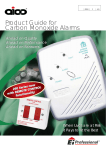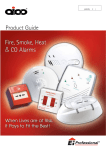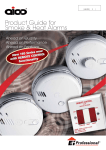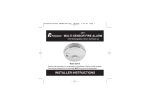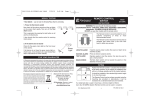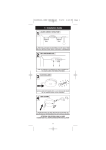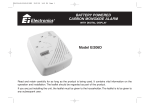Download to - Latest from Brooks New Zealand
Transcript
Frequently Asked Questions Carbon Monoxide Alarms Frequently Asked Questions CO ALARMS 1. What is Carbon Monoxide? Carbon Monoxide (CO) is an invisible, odourless, tasteless and extremely toxic gas. It is absorbed by red blood cells in the lungs in preference to Oxygen - this results in rapid damage to the heart and brain from Oxygen starvation. 2. Where does CO come from? It is produced by appliances or vehicles powered by any fuel such as coal, oil, natural and bottled gas, paraffin, wood, petrol, diesel, charcoal, etc. Normally it is vented out of a building through chimneys or flues. There are a variety of situations which can arise which may lead to CO filtering into the home instead of being vented into the outside atmosphere: A cracked heat exchanger on the gas central heating system This is a particularly dangerous source of CO, as leakage often tends to be very heavy. This problem can arise as a result of consumers not getting their appliance serviced every year and, in some cases, improper maintenance and servicing by the contractor hired to do the job. Disconnected, cracked, rusted or corroded flue pipe or vent In the UK, this is an area of great importance. Even in those homes that do have their central heating checked annually, flues and vents may not be adequately checked. If a flue cracks, CO will leak into the home. Many recent cases of CO poisoning have been as a result of poorly installed flues. Blocked chimney, vent or flue This is an area of crucial concern as inadequate ventilation is the main cause of Oxygen starvation, increasing the levels of CO. It is a subject that has been researched by the Gas Consumers Council (GCC), now Energy Watch. Two million complaints were recorded over a five year period and it was the most common gas consumer complaint. Research reveals that poor construction, quality control standards and ignorance are to blame. Improper appliance installation Instances of this have occurred recently; improper appliance installation resulted in a fatality and, when investigated, it was revealed that the Council concerned had used the same contractor to fit over 2,000 of the same gas units, all of which were subsequently found to have been incorrectly installed. 2 CO ALARMS Frequently Asked Questions Reverse stacking Any of the above problems with appliances may result in the occurrence of reverse stacking. This arises with appliances which distribute air through air ducts into all parts of the home. If the ventilation process is inhibited for whatever reason, when the appliance draws in air to burn gas, CO will also be drawn in, resulting in it being circulated through air ducts to all parts of the home. Backdrafting With an increase in the number of devices which extract the air from the home, e.g. bathroom extractor fans and kitchen vents, in conjunction with the more energy efficient homes, a negative pressure situation may occur within a home. This results in a reverse in the airflow spilling CO into the living area. The severity of CO emissions in the home will often be exacerbated in new energy efficient homes, particularly where double glazing has been installed. This removes the draughts so often associated with older properties where a natural ventilation system existed. Appliances without flues Some appliances do not have flues, for example gas cookers. These can cause CO poisoning particularly if used for long periods e.g. to heat a room. 3. What are the symptoms of CO poisoning? Heavy doses of CO will cause a person to collapse and die within minutes. Lesser doses can cause headaches, drowsiness, fatigue, nausea, vomiting and flu like symptoms. The symptoms of poisoning vary depending on the level of absorption by the human body. While most people are aware that high levels of CO are harmful, it is less well known that the length of exposure is also important. A relatively low level of CO for a long period can cause the same symptoms as a high level of CO for a short period. The table on page 4 shows the concentration of CO measured in parts per million and the time taken for symptoms to develop. A major problem is that the symptoms of CO poisoning - headaches, dizziness, nausea - can easily be confused with other illnesses, particularly colds or flu. Consequently, the medical profession is often not able to readily identify the true cause of the problem until it’s too late. 3 Frequently Asked Questions CO ALARMS Effects of Cumulative CO Exposure CO Parts per Million (ppm) 4 Inhalation Time (approx.) & Symptoms Developed 35ppm The maximum allowable concentration for continuous exposure in any 8 hr period according to Occupation Safety & Health Association 150ppm Slight headache after 11/2 hrs 200ppm Slight headache, fatigue, dizziness, nausea after 2-3 hrs 400ppm Frontal headache within 1-2 hrs, life threatening after 3 hrs, also maximum ppm in flue gas (on air free basis) according to US Environmental Protection Agency 800ppm Dizziness, nausea and convulsions within 45 minutes. Unconsciousness within 2 hrs. Death within 2-3 hrs 1,600ppm Headache, dizziness and nausea within 20 minutes. Death within 1 hr 3,200ppm Headache, dizziness and nausea within 5-10 minutes. Death within 25-30 minutes 6,400ppm Headache, dizziness and nausea within 1-2 minutes. Death within 10-15 minutes 12,800ppm Death within 1-3 minutes CO ALARMS Frequently Asked Questions 4. How big is the problem of CO poisoning? It is a regrettable situation that the number of people killed or injured by accidental CO poisoning is unknown. Hospitals stopped recording incidents some time ago, but the last estimate was 200 deaths per year, with an unknown number of non-fatal occurrences. Research undertaken in 1994 in a sample of 250 homes, showed that 10% of households had a higher level of CO than would normally be expected. On a national scale, this could mean that as many as 2 million homes have CO levels higher than the minimum safe level. More recent research, January 2006 by UCL, found that 18% of the homes surveyed had CO levels that exceeded the World Health Organisation guidelines. Another interesting point revealed in research was that over half of all the people interviewed thought that CO had a smell, which would be quickly recognised and alert the residents that there was a danger present in the home. Also, the residents of over 35% of the homes visited admitted that they had not had appliances serviced in 3 years. After the above findings, it was decided to carry out further research by interviewing doctors to give their likely diagnosis of patients presenting symptoms of headaches, dizziness and nausea. It was interesting to learn that many possible diagnoses were given but not one doctor interviewed, suggested CO poisoning. When the doctors were asked, in the event of a patient persistently complaining of the above symptoms, would a carboxyhaemoglobin test be carried out, nearly all of the doctors said “No” and most of them being questioned were unsure at what level of carboxyhaemoglobin flu like symptoms start to occur. The most recent activity regarding CO safety has been the publication of a report by the House of Commons All Party Parliamentary Gas Safety Group in September 2006. The report titled “Shouting about a silent killer, Raising carbon monoxide awareness” has raised serious questions concerning the dangers of CO poisoning in the home. Excerpts from the report: • Too many people continue to be harmed or even killed as a result of this entirely preventable problem. • One death from CO poisoning is one too many. 5 Frequently Asked Questions CO ALARMS • Improving CO detection by emergency workers and increasing the number of reliable CO detectors in the home is key to the fight to tackle CO poisoning incidents. • Every home should have a CO detector with an audible alarm. • We call on mortgage and insurance companies to investigate whether requiring all homes to have such an alarm should be part of granting a mortgage or insurance cover. • The HSE has an important role to play. We press the HSE to introduce a zero-fatality target on CO poisoning. • Stacy Rogers (Dominic Rogers Trust) proposed that CO alarms should be a mandatory requirement for all rented accommodation. 5. How can I protect myself and my family from CO? Install CO detectors and test regularly to make all family members familiar with their distinctive sound. Make everyone aware of the symptoms of CO poisoning. Have all appliances serviced regularly, ensure that air vents are not blocked. 6. Why do I need a CO alarm? Many people are killed each year, and many more suffer ill health from CO poisoning. If the CO is not correctly vented due to a leaking or blocked chimney or a faulty heating appliance, dangerous levels of CO can build up inside the home instead of being vented outside. People are most vulnerable whilst asleep or nodding off by their fireside. 7. I have no gas burning appliance in my house - do I need a CO alarm? Gas appliances, although a major risk if not maintained properly or given adequate ventilation, are not the only source of CO. Other appliances burning solid fuel, bottled gas, paraffin, wood, petrol, diesel, charcoal etc. also produce CO gas. 8. How does the Ei range of CO alarms work? There are different types of CO sensors which, because they work in different ways, have different characteristics. All Ei CO alarms use a new generation proven electrochemical cell type sensor. This sensor type has a low power requirement well suited for use in a battery powered alarm in order to avoid frequent battery replacement. The electrochemical sensor works by catalytic action in direct proportion to the amount of CO present. It has a minimum 5 year life expectancy with good immunity to contaminant gases. 6 CO ALARMS Frequently Asked Questions 9. Where should a CO alarm be sited? The BS EN 50292 Code of Practice (COP), which is a guide to selection, installation, use and maintenance of CO alarms, states “it is not possible to give specific guidance on the exact location of a CO detector”. However, it does say that, where the CO alarm is located in the same room as the apparatus, if the CO alarm is mounted on the ceiling (our preferred position) it should be at least 300mm from any wall. We would add the recommendation that there should also be 300mm between the CO alarm and any other form of obstruction e.g. a light fitting. The COP goes on to say that if the CO alarm is mounted on the wall, it should be at least 150mm from the ceiling, but above the height of any door or window. Whether ceiling or wall mounting, the CO alarm should be between 1m and 3m (measured horizontally) from the potential source of CO. The CO alarm should not be installed: • • • • In an enclosed space e.g. a cupboard Where it can be obstructed e.g. by furniture Directly above a sink Next to a door, window, extractor fan, air vent or similar ventilation openings • Where the temperature may drop below - 5ºC or exceed 40ºC 10. How many CO alarms should I fit? The BS EN 50292 guide recommends that, ideally, you should have a detector in every room that contains a fuel burning appliance. However, if you have more than one appliance, but only one detector, you should consider the following priority areas when deciding where best to put the detector: rooms containing a flue-less or open-flued appliance; rooms where the occupants spend most time; rooms in which the appliance is most used. The guide further suggests that you should consider fitting CO alarms, or repeaters in other areas where there is no appliance but the occupants spend considerable time and may not hear an alarm sited elsewhere in the property. These areas could include sitting rooms and bedrooms. In these areas wall mounting at normal breathing height is suggested as the more appropriate siting position. 7 Frequently Asked Questions CO ALARMS 11. Why does the time for the horn to come on depend on the concentration of CO? The micro-chip in the unit calculates the toxic level of CO gas/exposure time in a similar way to the human body. Warnings are given for both high CO levels for short periods, and lower CO levels for longer periods. It will ignore brief exposures which do not have any harmful effect. 12. How do Ei CO Alarms conforming to BS EN 50291 give warning? When the CO Alarm detects potentially dangerous levels of CO, a red light on the cover will flash. The alarm will sound if the CO levels persist, or rise. The table below shows how the alarm reacts to different levels of CO and exposure. CO level in ppm 50ppm 100ppm 300ppm Red alarm light 1 flash every 2 seconds 2 flashes every second 4 flashes every second Sounder operates Within 60 to 90 mins Within 10 to 40 mins Within 3 mins The Ei261DENRC will indicate the ppm CO detected (above 50ppm) on the digital display on the front panel of the alarm cover. 13. Can the alarms be interconnected? The Ei Professional model Ei261ENRC and Ei261DENRC (mains operated with Rechargeable Lithium cells) can be interconnected to other Ei261ENRC and Ei261DENRC units so that when one senses CO, they will all alarm. Twelve units may be interconnected, but only the unit sensing CO will have its red light lit in order to identify the area in which CO was detected. We would recommend that when more than one CO alarm is installed in a property they should be interconnected. 14. Can I signal to other devices from a CO alarm? Yes, either an Ei261ENRC or Ei261DENRC can be used with a remote relay model Ei128RBU (with Ei128COV cover), which is rated at 5 Amps. The relay can be used to switch shut off valves, sounders or strobes, or signal to other suitable remote devices as required. The relay has an optional pulse feature, which is suitable for signalling to Warden Call Systems widely used in Sheltered Housing Schemes. 8 CO ALARMS Frequently Asked Questions 15. Can I interconnect CO alarms to a smoke alarm system? There is merit in interconnecting CO and smoke/heat alarm systems, as it will improve audibility throughout the property However, it is generally considered that interconnecting CO alarms into a smoke/heat alarm system is not good practice, as the actions that should be taken in the different emergencies are quite unique: • If a fire occurs, you should keep doors and windows closed to contain the fire as much as possible. • If a CO leak occurs, you should open all doors and windows to ventilate the area as much as possible - at the same time turning off the appliance/s from where CO leak is being emitted. We believe that interconnection between the 2 types of systems may be considered if the user is able to determine which of the alarms has caused the system to operate (the smoke alarm or the CO alarm) so enabling them to make the correct decision on what action should be taken. The only foolproof method of achieving this is by having a means of silencing the remaining system i.e the alarms not actually sensing smoke or CO. The solution to this problem would be the addition of an Ei1529RC Alarm Control Switch into the system. If any of the alarms in the system operate (CO, smoke or heat) it is only necessary to press ‘Locate’ on the Ei1529RC switch. This will silence all alarms that are not actually sensing either CO, smoke or heat, enabling the user to quickly and easily identify which of the alarms is sounding. This gives complete control over the system allowing the occupant to take the safest action according to the problem identified. Additionally, if found to be a false alarm, simply press 'Hush’ on the control switch to silence the alarm. The entire alarm system can also be tested regularly by pressing the ‘Test’ switch. The Ei261ENRC and the Ei261DENRC CO alarms have an interconnect feature that allows them to be interconnected with any of the Ei160RC series smoke and heat alarms (Not RadioLINK models). Adding the Ei1529RC switch is a simple job, only requiring a 3 core connection from the alarm (smoke,heat or CO) closest to where the Ei1529RC switch is to be installed. 16. Do they meet the standards? All Ei CO alarms comply with BS EN50291: 2001 and they are Kitemarked to show that they have been third party tested to this standard. 9 Frequently Asked Questions CO ALARMS 17. Do the CO alarms have back-up power? The mains operated models Ei261ENRC and Ei261DENRC are supplied complete with sealed-in tamper proof Rechargeable Vanadium Pentoxide Lithium standby cells, designed to last at least 10 years without the need for replacement and can power the unit for a minimum of 30 days in the event of mains failure. The battery is monitored, and if it starts to become depleted (i.e. with mains off), or if it becomes defective, the unit beeps every 40 seconds. 18. Are the mains operated models Ei261ENRC and Ei261DENRC easy to fit? Yes, these models are supplied with an `Easi-fit` surface mounting plate, with integral terminal block and cable cover. The terminal block is permanently fitted to the mounting plate. The built-in battery connects as the unit is slid on to the plate. Conduit (up to 25 x 16mm) can be attached to the top or bottom of the unit for surface wiring. The units can be ceiling or wall mounted. 19. Will I get false/nuisance alarms? Every effort has been made to make the unit insensitive to normal household chemicals. However, units may go into alarm if cigarette smoke is deliberately blown into the unit, or if aerosols, paints or similar materials are used nearby. All Ei CO alarms are fitted with a manual test/hush button which, when pressed, will silence low levels of CO gas for approximately 5 minutes. The unit will then automatically re-set to standby mode. For safety reasons the hush feature cannot over-ride an alarm caused by dangerously high levels of CO. 20. How often should they be tested, and do they have to be serviced? The CO alarm should be tested weekly by pressing the test button. The alarm may be cleaned externally with the narrow nozzle of a vacuum cleaner and wiped down with a damp cloth (disconnect the mains on Ei261ENRC/Ei261DENRC/Ei225EN models). The sensor may be tested annually in CO gas to ensure that it is fully operational. To simplify this process, all Ei CO alarms have a “quick test” feature. Pressing the test button causes the unit to sample for CO every 4 seconds so that when CO gas is injected into the sensor it will respond almost immediately with 3 short beeps. The alarm will automatically re-set to standby within 3 minutes. Apart from sensor replacement after 5 years (Ei261ENRC and Ei261DENRC only) no other servicing is required (see 22 below). 21. How will I know if it is my CO alarm or my smoke alarm? The Ei range of CO alarms have a distinctive on-off sound of 3 pulses, followed by a pause, as compared with a typical smoke alarm which has a rapid pulsing sound. In addition, when the CO alarm is detecting CO, the red light in the centre of the cover will flash. 10 CO ALARMS Frequently Asked Questions 22. How long does the unit last? The CO alarms are sophisticated electronic devices with many parts, including the sensors, and will not last indefinitely. We recommend that the Ei205ENA and Ei225EN models should be replaced after 5 years in operation. The mains operated models Ei261ENRC and Ei261DENRC are designed to last 10 years and have a replaceable sensor module, which we recommend be replaced after 5 years use. This simply requires the pulling out of the sensor module from the rear of the alarm and replacing with a new sensor module (Ei261MEN) readily available at a modest cost. 23. What should I do when the alarm goes off? • • • • 24. How much electricity does a mains operated CO alarm use? The Ei261ENRC/Ei261DENRC/Ei225EN models use only one unit of electricity per week. 25.Will it detect other gases? The Ei CO alarm is precisely calibrated so that it will only detect CO gas. IT WILL NOT detect the presence of natural gas (methane), propane, butane or other combustible gases/fuels. Therefore, a detector specific to the other gas, or gases, that may be present must be used in addition to the CO detector, as required. 26.Can I use it instead of a smoke alarm? No! CO alarms are not suitable as early warning fire alarms. Fire produces CO, however the measured response of the CO alarm could allow a fire to get out of control before it warned of danger. Smoke alarms must be fitted for protection against fire. 27.Why are CO alarms more expensive than smoke alarms? The technology used in Ei CO alarms is much more complex and sophisticated than smoke alarm technology. Cheaper less sophisticated CO alarms are available, but they may not be as reliable and are commonly prone to false alarm. Open the doors and windows to ventilate the area. Stop using the appliance; turn it off if possible. Evacuate the property leaving the doors and windows open. Ring your gas or other fuel supplier on their emergency number; keep the number in a prominent place. • Do not re-enter the property until the alarm has stopped. • Get medical help immediately for anyone suffering the effects of CO poisoning (headache, nausea) and advise that CO poisoning is suspected. • Do not use the appliance again until it has been checked by an expert; in the case of gas appliances this must be a CORGI registered installer. 11 Frequently Asked Questions Carbon Monoxide Alarms Sydney Newcastle +61 2 9684 1466 +61 49362744 Adelaide Perth +61 8 8347 0000 +61 8 6262 8095 Australia: www.brooks.com.au Brisbane Melbourne +61 7 3373 8222 +61 3 9879 5294 New Zealand +64 9 638 4644 New Zealand: www.brooks.co.nz












